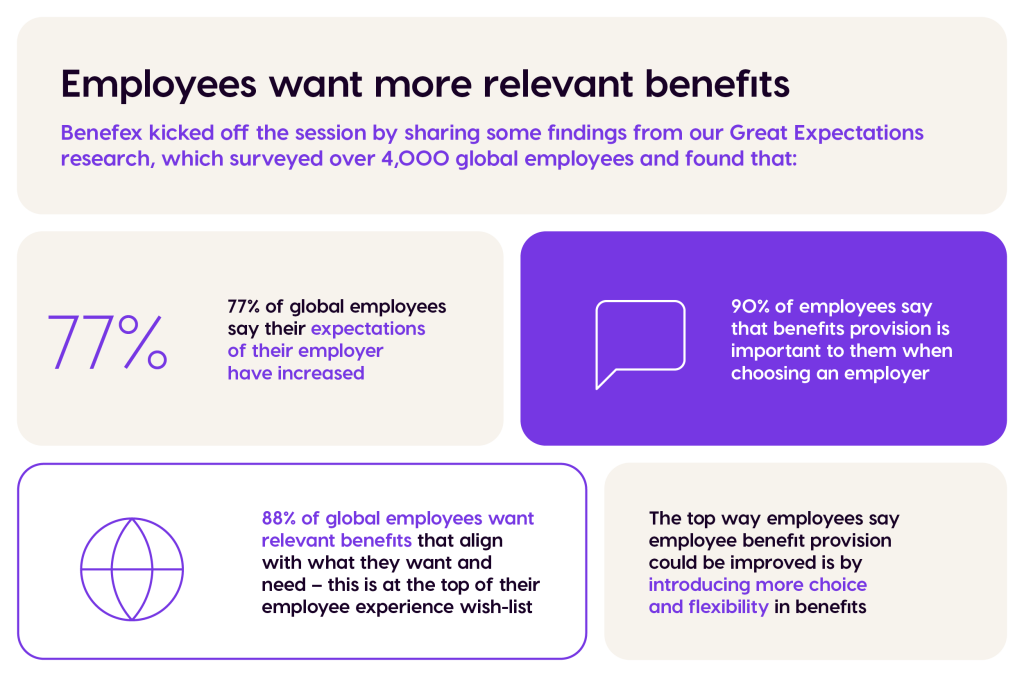
Employee Benefits
“It’s not a one-size-fits-all approach”- Making global benefits flexible, personalised and relevant
17-04-2023
At our recent roundtable, benefits and HR leaders explored the challenges of rolling out a benefits programme to different regions – and discussed strategies for ensuring benefits are flexible and relevant, even where local benefits options are limited. Organisations in attendance included Lendlease, Link Group, MUFG Investor Services, Maples Group, Sony, Hiscox, Cohort, Computacenter, and more.
Global reward directors have a lot on their plate; not only are they responsible for ensuring their organisation has a competitive and attractive benefits package across all regions, they’re also responsible for technology implementation, compliance, employee wellbeing – and they’re facing ever-increasing expectations from employees across all areas of the employee experience.
Every six months, we facilitate a round-table discussion with our Global Benefits Leaders group – where senior benefits, reward and HR professionals get together to discuss the latest global benefits trends, challenges, solutions and innovations. At our most recent roundtable, Benefex’s EVP Global, Adam Mason, Global Benefits Director, Paul Andrews, and CSMO, Will Davidson, were joined by 10 attendees from a range of industries, including construction, finance, and technology.
The theme of the discussion was ‘how to achieve hyper-personalisation with flexible spending allowances.’ The group shared their stories of using allowances to support the wellbeing of their global employees and provide choice where local benefit offerings are limited. They shared anecdotes of what has – and hasn’t – worked for them. Here are some of the highlights…

Although the attendees have different priorities and have employees in different countries, there was agreement that ensuring benefits are relevant is essential to drive engagement – it’s clear that employees want more choices, personalisation and benefits that are tailored to their specific life stage.
But being relevant doesn’t always require a complicated or expensive solution. It’s a question of asking employees what they need and would value most. Two attendees mentioned a region where employees had really wanted a bus to take them to work and back every day (in one case a manufacturing site and in the other an office campus) – this was the most meaningful benefit to them as it solved a pain-point employees were experiencing; a commute that was costing them time and money.
There was some discussion around how different demographics value different benefits – for example, someone with dependants may value core benefits like life assurance more than someone who is just entering the workforce, whereas benefits like holiday purchase are popular with younger employees. Enabling employees to flex core benefits up and down helps employees to get the benefits they want most, and some organisations allow employees to put any amount left over into a spending account.
From global to local: tailoring your strategy
Outside of a few countries such as the UK, USA and Republic of Ireland, where there’s a wide-ranging benefits market, benefits options can be very limited.
Although many organisations want to provide a consistent level of benefits for their global employees, this is difficult to achieve – with benefits leaders having to contend with varying levels of benefits availability, cultural considerations, language, and differing premiums.
Private medical insurance was discussed as an example of a benefit that’s a crucial requirement in some regions (e.g. USA) and not others (e.g. Germany).
Participants agreed that localisation is needed to make a global benefits programme successful. Not all benefits are relevant for all locations, so it’s important to unpick the goals behind global benefits strategies, take stock of what’s in place, and see what employees need most.
Flexible spending accounts are growing in popularity
With employees seeking increased flexibility and personalisation of benefits, employers are using creative solutions like flexible spending accounts to enable employees to choose a solution that’s right for them, within certain parameters set by the company.
Flexible funds are an amount that companies provide their employees with to spend on flexible benefits, which employees can select through their benefits platform. For example, they can flex their core benefits like private medical insurance to a higher level or choose additional flexible benefits options like holiday purchase or wellbeing/fitness benefits.
With flexible spending accounts (also often referred to as benefits, lifestyle, wellbeing and spending accounts), employees are given an amount to spend on an activity that will be valuable to them, outside of what’s on offer. For example, a wellbeing or lifestyle activity that the employee pays for themselves and then claims the costs back. This can be managed through a benefits platform.
Most roundtable attendees were already using or planning to introduce some form of spending account or allowance (or using both solutions together), to offer choice and flexibility to employees in regions where benefits options are limited – each attendee was implementing these slightly differently.
There's no one-size-fits-all approach
Some organisations provide specific wellbeing or fitness allowances, and others keep the use of allowances much more open. Those with stricter guidelines tend to use reimbursements, whereas others enable the employees to spend it without limitations.
As attendees pointed out, it can be hard to define what counts and what doesn’t count as something to support wellbeing. However, one organisation has seen an encouraging 80% of employees engaging with their wellbeing allowance, showing employees value the initiative.
One participant uses a flexible allowance in Singapore that employees can use to increase cover on core benefits such as life assurance – once benefits are selected, the unspent amount is made available as an allowance for things that aren’t included under the core medical policy. Using a platform simplifies the administration and provides a smoother experience for employees.
A few attendees highlighted that exchange rates can cause problems as they cause value of allowances to vary from country to country. For example, one organisation gave global employees a blanket $1,000 wellbeing payment during the pandemic which didn’t go down well with Nordic employees due to exchange rates but landed very well in Eastern Europe. And another highlighted that sometimes employees can find spending allowances difficult to distinguish from salary; using tight guardrails to define what the allowance can be used for was proposed as one solution to this challenge, making it feel like more of a defined benefit for employees.
Ultimately, how benefits leaders implement flexible funds and spending accounts will depend on the needs of employees and the goals of the programme.
The importance of communicating benefits with employees
Another common theme that ran through the session was the importance of communication to ensure employees get the most from their benefits, understand what is on offer – and know how to take action.
Whether it’s core benefits or flexible allowances, clearly communicating what’s available to employees, how they’ll benefit, and making it as easy as possible for them to make selections will ensure higher uptake and better employee outcomes.
Where next?
Start with strategy. For organisations looking to rollout benefits to new countries, the first step is to understand employees’ needs, the goals behind the programme, and see what’s feasible or already in place in the local market. Where there are multiple countries to tackle, it’s important to prioritise regions and put a rollout plan in place. Then you can start to implement relevant benefits, rollout benefits technology, and use allowances to plug any gaps.
Take a look at our guide, Going global with benefits: A guide to rolling out employee benefits technology across 12 key countries to explore the benefits landscape in some of the most popular countries where our customers are rolling out employee benefits technology.
And if you’d like to hear learnings from other global benefits leaders who are rolling out benefits across the world, keep an eye on our events page for the next Global Benefits Leaders roundtable or global benefits masterclass.


